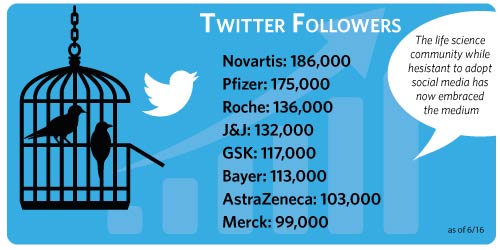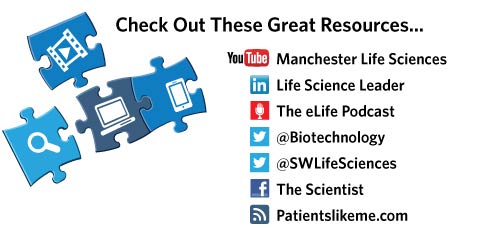
Using Social Media to Bring Life to Life Sciences
- Published
- Jun 16, 2016
- Share
Famed criminal Willie Sutton was asked why he robbed banks. His response: “Because that’s where the money is.” Well, today social media is where people are: Twitter (300 million active users); LinkedIn (430 million members); Facebook (900 million users); YouTube (1 billion subscribers). A recent survey found that 2/3 of doctors use social media for professional purposes. Those numbers are hard to ignore.
Life scientists were among the first professionals to use the Internet to communicate, collaborate and contribute. But for a long time, the life sciences sector shied away from social media. And while their reasons were plausible, they have since embraced social media. In fact, many life science companies have some of the most engaging, successful programs around.

Government Regulation
The FDA held its first public meeting on social media in 2009. It subsequently released its initial guidance on “Responding to Unsolicited Requests for Off-Label Information About Prescription Drugs and Medical Devices.” Even though social media is not mentioned in the title, it was a first step by the FDA to address how to proceed with potential adverse events notifications on social platforms. Since that time, FDA warning letters to life science companies for social media use have been extremely rare. Even the FDA jumped on the social media bandwagon. It has more than 130,000 Twitter followers and 13,000 YouTube subscribers.
Passive Versus Active Social Media
Just what are life science companies using social media for? Initially, life science professionals did “social listening.” This passive approach includes monitoring pharmacovigilance and customers’ unmet needs, what health care providers were saying, competitor activities, or how the media covered a product or company. “Before you’re tempted to jump into social media, it really makes sense to first step back. See what’s going on in the industry, particularly one with significant privacy concerns such as life sciences,” says Alicja Patela, EisnerAmper’s social media manager.
Social listening, however, can only take you so far. A competent social media strategy includes two-way communication. Life science companies can actively engage their varied audiences through blogs, tweets, videos, podcasts and more. For example, they can tweet a toll-free number to patients who are experiencing side effects or provide a YouTube video to health care professionals on how to administer a product. ResearchGate, funded by Bill Gates, provides a social network where 9 million scientists can share research and get peer feedback.
When communicating, it’s important to understand the nuances and differences of each group. Different types of patients, doctors and researchers may consume information differently. This is exemplified by patient-specific websites, such as ihadcancer.com or diabeticconect.com, where patients can share stories about treatment and recovery. Sermo, a social network for doctors, has 300,000 members.
Thought Leaders
The Holy Grail of social media is reaching the thought leaders, those key influencers who have online relationships in the thousands or even millions. A thought leader can be a doctor, researcher, patient advocate, caregiver, journalist or some other. It can be anyone who has built a significant online following based on the information, resources and opinions they offer. By engaging these thought leaders in a professional, fruitful manner, you can exponentially convey your message. One example of a thought leader is Regina Holliday. She became an advocate for clarity and transparency in medical records after her husband passed away from kidney cancer. Regina has more than 18,000 Twitter followers.

Housekeeping
While the user experience gets all the glitz, there are less-glamorous back-office aspects that need regular attention. First, determine who is responsible for creating, posting and monitoring content. It may the same person or several individuals—generally, the fewer the better.
Next, make sure you have the necessary controls in place. Whether performed internally or by an external vendor, data security—particularly in the life science sector—is critical.
Use data analytics to help measure results, whether it’s likes, shares or followings. Analytics can help determine the what, where, when and how much of your content delivery. Be fluid with your social media approach. If you find one platform isn’t working, try another.
Finally, because people live on their phones, your social media needs to be built for mobile devices as well as the web. There are more than 35,000 health-related apps, offering things such as Rx reminders to patients. Mobile content is the future.
Crowdfunding
Thanks to the 2012 JOBS Act, life science companies can now solicit funds from investors in exchange for equity via crowdfunding. Crowdfunding—raising contributions from a broad base of investors, often electronically—and social media were made for each other. However, there are considerations.
A successful crowdfunding campaign entails being on the same platforms as your supporters, whether it’s Twitter, Facebook, YouTube, LinkedIn or some combination thereof. Post interesting content regularly via text, photos and/or video. It might be a project update or a personal story of someone involved. In fact, as a rule of thumb, only after 20 posts of content (soft sell) should you then directly ask for a contribution (hard sell). Don’t forget to answer supporters’ questions, ask them to help spread the word and, perhaps most importantly, thank them for their contributions.
Conclusion
Whether you are using social media for internal collaboration on a product launch, showing employee volunteer work, offering a patient assistance program, giving sports safety tips for kids, or some other reason—be part of the dialog! Provide useful, timely content—that isn’t salesy—which includes a powerful image. Why not a video documenting a patient from illness through cure? (One picture really is worth 1,000 words.) Give people a reason to share your content and then you, too, can become a life science thought leader.
Catalyst - Summer 2016
Contact EisnerAmper
If you have any questions, we'd like to hear from you.
Receive the latest business insights, analysis, and perspectives from EisnerAmper professionals.







